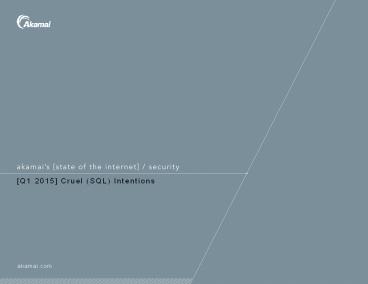Cruel SQL Injection | Web Application Attacks | Summary - PowerPoint PPT Presentation
Title:
Cruel SQL Injection | Web Application Attacks | Summary
Description:
Malicious actors continue to deploy SQL injection (SQLi) attacks to carry out their cybercriminal activities. The Threat Research team at Akamai designed a technique to categorize these attacks by examining attack payloads and determining the intent behind each attack. They analyzed 8 million SQLi attacks over a seven-day study period from Akamai's Kona Site Defender web application firewall (WAF) and distilled the information, identifying the observed attacks and their goals, as well as pertinent attack stats from the study. This presentation offers a quick view of the results. Get more details in the full State of the Internet Security Report at – PowerPoint PPT presentation
Number of Views:39
Title: Cruel SQL Injection | Web Application Attacks | Summary
1
Q1 2015 Cruel (SQL) Intentions
2
SQLi attacks case study
- Technique used to exploit web applications
- Attackers change the logic of SQL statements
executed against a database - Although not new, SQL injection (SQLi) attacks
continue to pose cloud security risks - Attackers may use the original or more evolved
SQLi exploitation methods - Automated injection tools streamline and simplify
the process
2 / The State of the Internet / Security (Q1
2015)
3
SQLi attack categorization
- Akamais Threat Research team developed a
technique to categorize SQLi attacks - This technique involved analyzing individual
attack payloads and determining intent behind
each one - The data included more than 8 million SQLi
attacks targeting more than 2,000 unique web
applications over a period of seven days
3 / The State of the Internet / Security (Q1
2015)
4
SQLi attack types
- Malicious actors typically assess a web
application for vulnerability to SQLi - The database structure is probed so that the
attacker can retrieve contents remotely - The login mechanism is bypassed, allowing the
attacker to escalate privileges - A common and classic payload would be to send the
payload OR 11 as the user name, then
attempting to escalate privileges by logging in
with user name admin or 11--.
4 / The State of the Internet / Security (Q1
2015)
5
SQLi attack types (continued)
- Other SQLi attack types can include
- Credential theft
- Data and file exfiltration
- Denial of Service (DoS)
- Data corruption
- Malicious file upload
- Website defacement and malicious content
injection - Remote command execution
5 / The State of the Internet / Security (Q1
2015)
6
SQLi probing and testing
- The most common SQLi attack over the seven-day
study period was SQLi probing and injection
testing. - As a first step, malicious actors will assess all
entry points of a web application in search for a
vulnerability - The attacker will send a wide range of characters
with syntactic meaning in SQL as well as
blind-injection related Boolean sequences or
timed queries - These queries naturally results in large volumes
of traffic - Nearly 60 percent of HTTP transactions are
attributable to these probing attempts
7 / The State of the Internet / Security (Q1
2015)
7
summary
- Malicious actors use a variety of SQLi techniques
to perform different tasks - These attacks can extend well beyond simple data
exfiltration, and have the potential to cause
more damage than a data breach - It is not safe to assume that SQLi attacks lead
only to data theft - Privilege escalation, command execution, data
infection or corruption, and denial of service
are among the many ways these attacks can harm
your business
8 / The State of the Internet / Security (Q1
2015)
8
Q1 2015 State of the Internet Security Report
- Download the Q1 2015 State of the Internet
Security Report - The Q1 2015 report covers
- Analysis of DDoS and web application attack
trends - Bandwidth (Gbps) and volume (Mpps) statistics
- Year-over-year and quarter-by-quarter analysis
- Attack frequency, size, types and sources
- Security implications of the transition to IPv6
- Mitigating the risk of website defacement and
domain hijacking - DDoS techniques that maximize bandwidth,
including booter/stresser sites - Analysis of SQL injection attacks as a persistent
and emerging threat
9 / The State of the Internet / Security (Q1
2015)
9
about stateoftheinternet.com
- StateoftheInternet.com, brought to you by Akamai,
- serves as the home for content and information
intended to provide an informed view into online
connectivity and cybersecurity trends as well as
related metrics, including Internet connection
speeds, broadband adoption, mobile usage,
outages, and cyber-attacks and threats. - Visitors to www.stateoftheinternet.com can find
current and archived versions of Akamais State
of the Internet (Connectivity and Security)
reports, the companys data visualizations, and
other resources designed to put context around
the ever-changing Internet landscape.
10 / The State of the Internet / Security (Q1
2015)































